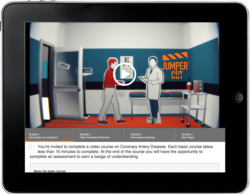JumperCut Launches Personalized Video Platform to Drive Patient Engagement
 JumperCut, an innovative provider of patent- pending interactive media and personalized video technology to drive patient engagement, today announced the launch of a beta program based upon the early success of its initial pilot programs. The beta program will be made available to select health plans, health systems, and other care coordination organizations that are struggling to facilitate and sustain digital conversations with patients, but who are simultaneously striving to meet the standards associated with Stage 2 Meaningful Use as defined by the Centers for Medicare and Medicaid Services (CMS).
JumperCut, an innovative provider of patent- pending interactive media and personalized video technology to drive patient engagement, today announced the launch of a beta program based upon the early success of its initial pilot programs. The beta program will be made available to select health plans, health systems, and other care coordination organizations that are struggling to facilitate and sustain digital conversations with patients, but who are simultaneously striving to meet the standards associated with Stage 2 Meaningful Use as defined by the Centers for Medicare and Medicaid Services (CMS).
Through an expanded deployment, JumperCut will be positioned to further gauge the effectiveness of personalized video as a complement, or alternative to more traditional patient education models through the evaluation of particular end- points, including information retention, goal-setting, and satisfaction across a variety of patient types. Dr. Philip Marshall, co-founder and CEO of JumperCut, observes, “Healthcare is in transition. And because there are now well-defined quality metrics that have been adopted nationally and regionally, we have the ability to focus patient engagement efforts around supporting those metrics. It’s important to payers and providers, not just because those metrics are driving reimbursement, but also because taken together they offer the promise of a better human experience, higher quality care, and lower overall costs.” Supporting this point-of- view, one finding from an article recently authored by the Robert Wood Johnson Foundation was that patients with the lowest engagement scores incurred 21 percent higher costs than patients who were highly engaged.
The JumperCut technology platform employs novel algorithms and utilizes a patient’s health information to assemble personalized video sequences that address a patient’s unique attributes and needs—providing a rich user experience, delivering relevant educational content, and enhancing the physician-patient relationship while supporting greater engagement. “We are pleased to be a participant in JumperCut’s early innovator program and have been excited by the results of our pilot,” stated Dr. Barry Wolcott, Chief Medical Officer at expert-24. “We are focused on developing and integrating patient-focused decision support systems for our healthcare clients. JumperCut’s ability to leverage de-identified patient data and deliver dynamic, personalized video conversations certainly aligns with, and augments, the solutions we offer.”
For more information about JumperCut, or to inquire about participating in its personalized patient education beta program, please e-mail information(at)jumpercut(dot)com or call 971.229.1942.
About JumperCut
JumperCut is a privately funded company that was founded in 2012 by a small team of dedicated technologists and healthcare professionals passionate about bringing new social and mobile video technologies to the market. The company is focused on delivering personalized experiences that more effectively engage patients, facilitate informed exchanges, and that help address escalating healthcare costs. Its advisory board is composed of industry thought-leaders and distinguished innovators.
Patient Engagement through Personalized Video
http://www.jumpercut.com
Portland, OR (PRWEB) June 11, 2013
JumperCut, an innovative provider of personalized video technology, announced a Beta Program for Health Plans, Health Systems, and Other Care Coordination Organizations.

Through an expanded deployment, JumperCut will be positioned to further gauge the effectiveness of personalized video as a complement, or alternative to more traditional patient education models through the evaluation of particular end- points, including information retention, goal-setting, and satisfaction across a variety of patient types. Dr. Philip Marshall, co-founder and CEO of JumperCut, observes, “Healthcare is in transition. And because there are now well-defined quality metrics that have been adopted nationally and regionally, we have the ability to focus patient engagement efforts around supporting those metrics. It’s important to payers and providers, not just because those metrics are driving reimbursement, but also because taken together they offer the promise of a better human experience, higher quality care, and lower overall costs.” Supporting this point-of- view, one finding from an article recently authored by the Robert Wood Johnson Foundation was that patients with the lowest engagement scores incurred 21 percent higher costs than patients who were highly engaged.
The JumperCut technology platform employs novel algorithms and utilizes a patient’s health information to assemble personalized video sequences that address a patient’s unique attributes and needs—providing a rich user experience, delivering relevant educational content, and enhancing the physician-patient relationship while supporting greater engagement. “We are pleased to be a participant in JumperCut’s early innovator program and have been excited by the results of our pilot,” stated Dr. Barry Wolcott, Chief Medical Officer at expert-24. “We are focused on developing and integrating patient-focused decision support systems for our healthcare clients. JumperCut’s ability to leverage de-identified patient data and deliver dynamic, personalized video conversations certainly aligns with, and augments, the solutions we offer.”
For more information about JumperCut, or to inquire about participating in its personalized patient education beta program, please e-mail information(at)jumpercut(dot)com or call 971.229.1942.
About JumperCut
JumperCut is a privately funded company that was founded in 2012 by a small team of dedicated technologists and healthcare professionals passionate about bringing new social and mobile video technologies to the market. The company is focused on delivering personalized experiences that more effectively engage patients, facilitate informed exchanges, and that help address escalating healthcare costs. Its advisory board is composed of industry thought-leaders and distinguished innovators.
Patient Engagement through Personalized Video
http://www.jumpercut.com

